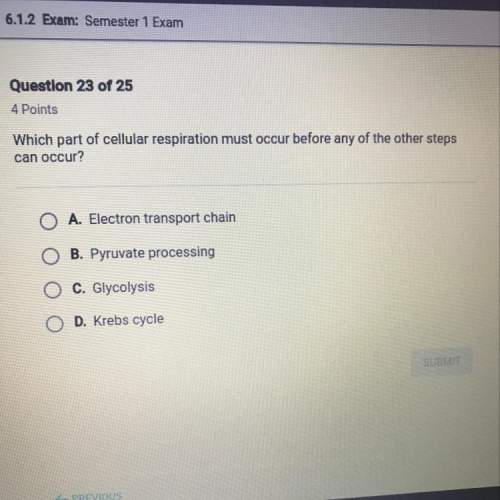

Answers: 2


Other questions on the subject: Biology

Biology, 21.06.2019 13:30, genyjoannerubiera
What role does differential reproduction play in natural selection? ! a) some organisms have different reproductive success due to nongenetic traits. b) some organisms have traits that them reach reproductive age. c) different methods of reproduction result in some organisms being genetically altered. d) reproduction varies among organisms due to pathogenic factors. the answer is not a or d based on other posts.
Answers: 2

Biology, 21.06.2019 17:00, editsa
The construction of phylogenetic trees is a mapping out the proposed divisions and common ancestors of all living species. traditionally, these trees have been built using morphological data, such as appearance and embryology. recently, it has been possible to construct these trees using molecular data. phylogenetic trees based on different types of information agree with each: that there is strong evidence of a real underlying common descent. this phylogenic tree is composed based on molecular data (rrna). what statements can we infer are true about the organisms throughout the tree? because the tree is rooted, all branches share a common ancestor. all organisms have some sort of cellular structure/organization. all eukaryotes evolved from bacteria. since the organisms contain rna, they share the same dna. if the organisms contain rna, the share the same four nitrogen bases.
Answers: 1

Biology, 21.06.2019 20:30, alevans7144
For your initial isolation of the bacterium, you simply needed to grow enough of it that you could identify some of its more general features. thus, you used a complex nutrient agar that would allow for the growth of almost any bacterial species. different bacterial species often have very specific requirements for life. this is a fact that you can utilize when you are trying to identify the bacterium to the species level. growth conditions that will permit the growth of one species but not another may allow you to select which one you would like to culture. you can utilize different selective/differential media that allow for the growth of only one type of bacteria (e. g., either gram positive or gram negative). culturing media such as phenylethyl alcohol or sodium chloride agar will be selective/differential for gram-positive bacteria. you may also want to show that it is different from other bacteria that may be present, so you could use a selective/differential agar. selective/differential media such as blood agar or phenol red sugar broths allow for the determination of whether a bacterial cell can grow and utilize specific ingredients included in the medium and turn the agar a distinct color. sheep's blood agar utilizes red blood cells to differentiate which bacterial species may have hemolytic properties. selective or differential? 1. an agar that uses a high salt concentration to limit the growth of one type of bacteria over another would be considered selective/differential. 2. if an agar contains a dye or ph indicator in the presence of a sugar, it is generally considered selective/differential for those bacteria that may ferment the sugar over those that cannot. 3. an agar that uses the dye in crystal violet agar suppresses the growth of gram-positive bacteria. this agar would be considered selective/differential. 4. the selective/differential aspect of macconkey agar allows for the determination of which bacteria are lactose fermenters and which are not. 5. a blood agar plate contains sheep red blood cells and allows for the determination of hemolytic capabilities for all bacteria that grow on the agar. this would make this type of agar selective/differential. 6. emb agar uses lactose and two dyes that allow it to be selective/differential between the blue-black colonies of e. coli and the pinkish colonies of all other enteric bacteria. 7. bile salts in macconkey agar allow for the agar to be selective/differential for the growth of enteric gram-negative bacteria over gram-positive bacteria. 8. an agar that allows for the distinction of bacteria based on metabolism would be considered selective/differential.
Answers: 1

Biology, 22.06.2019 03:50, ashleybarrera2000
Connection compare and contrast genetic engineering to the process of natural selection. select all statements that are true.
Answers: 1
You know the right answer?
Which type of limiting factor affects a large population more than it affects a small population? <...
Questions in other subjects:


English, 01.12.2019 08:31

Chemistry, 01.12.2019 08:31



Medicine, 01.12.2019 08:31


Mathematics, 01.12.2019 08:31





